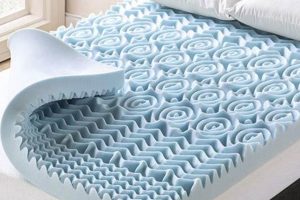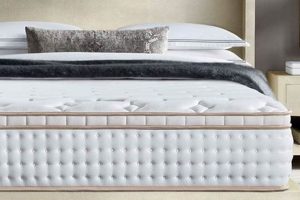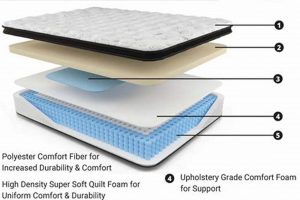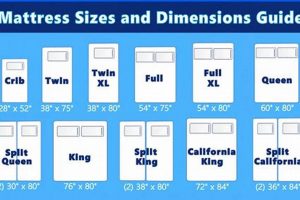A sleep surface addition crafted from resilient material, four inches in thickness, can modify the feel of an existing mattress. These products typically consist of either memory foam, known for its conforming properties, or latex foam, valued for its responsiveness and durability. For example, an individual with a firm mattress might select this type of product to introduce a softer, more pressure-relieving surface.
The use of these comfort layers can significantly improve sleep quality by addressing issues such as pressure points and inadequate support. Historically, adding layers to mattresses to enhance comfort has been practiced for centuries. Modern iterations, however, leverage advanced materials and manufacturing techniques to provide consistent and long-lasting performance, offering a cost-effective alternative to replacing an entire mattress.
The following sections will delve into the specific types of foam employed in these products, outline their key characteristics and benefits, and provide guidance on selecting the appropriate thickness and density for individual needs and preferences. Further discussion will cover maintenance, lifespan considerations, and common misconceptions surrounding these sleep accessories.
Guidance on Optimizing a Sleep Surface Addition
The following recommendations aim to maximize the advantages offered by the selected sleep surface enhancement. Proper implementation and maintenance are crucial to ensuring optimal comfort and longevity.
Tip 1: Assess Existing Mattress Condition: Before implementation, evaluate the current mattress for sags, lumps, or unevenness. This product is designed to enhance, not correct, underlying structural deficiencies. An unstable base will diminish the potential benefits.
Tip 2: Consider Density and ILD Rating: Density, measured in pounds per cubic foot, influences durability. Indentation Load Deflection (ILD) indicates firmness. Higher density generally equates to longer lifespan. Choose an ILD suitable for individual comfort preferences and body weight.
Tip 3: Utilize a Mattress Protector: Protect the investment from spills, stains, and allergens with a waterproof and breathable mattress protector. This preventative measure significantly extends the product’s lifespan and maintains hygiene.
Tip 4: Ensure Proper Support System: Confirm that the bed frame provides adequate support across the entire mattress surface. Insufficient support can lead to premature degradation and uneven wear, negating the benefits of the added comfort layer.
Tip 5: Allow for Initial Expansion: Upon unpacking, allow the item to fully expand and air out for at least 24-48 hours in a well-ventilated area. This process eliminates any residual odors from manufacturing and ensures proper dimensional recovery.
Tip 6: Rotate Regularly: To promote even wear and prevent body impressions, rotate the enhancement 180 degrees every three to six months. This simple practice contributes to consistent comfort and prolonged usability.
Tip 7: Follow Manufacturer’s Cleaning Instructions: Adhere strictly to the cleaning guidelines provided by the manufacturer. Incorrect cleaning methods can damage the foam structure and compromise its performance characteristics.
Implementing these guidelines ensures that the chosen sleep surface addition delivers its intended benefits of enhanced comfort, improved support, and prolonged mattress lifespan. Careful consideration of these factors will optimize the investment and contribute to a more restful sleep experience.
The subsequent sections will explore specific product variations, address common concerns, and offer further insights into maximizing the value of this sleep-enhancing addition.
1. Thickness and Density
Thickness and density are primary considerations when evaluating a sleep surface addition. These parameters directly impact its comfort, support, and durability. In the context of a four-inch model, variations in density can dramatically alter the overall performance and suitability for individual needs.
- Support Characteristics
Density dictates the level of support provided. Higher density materials offer greater resistance to compression, resulting in a firmer feel and better spinal alignment, especially for individuals of higher body weight. Lower density products compress more easily, providing a softer surface but potentially sacrificing support, leading to discomfort or exacerbation of existing back issues.
- Durability and Longevity
Density is a strong predictor of product lifespan. Higher density foam exhibits greater resistance to wear and tear, maintaining its shape and support characteristics over time. Lower density foam is more prone to degradation, compression, and the development of body impressions, necessitating more frequent replacement.
- Pressure Relief Capabilities
While thickness contributes to overall pressure relief, density influences how effectively the foam conforms to the body’s contours. High-density memory foam, for example, excels at distributing weight and alleviating pressure points. The interaction of thickness and density is crucial for users seeking relief from conditions like arthritis or fibromyalgia.
- Temperature Sensitivity
Density can affect how warm the topper retains heat as an addition to existing mattress. Higher density materials, especially memory foam, tend to retain more heat due to reduced airflow. The design of open-cell structures in higher density foams improves air circulation by creating channels for heat to dissipate. Balancing density with material composition is key to achieving a comfortable sleeping temperature.
In summary, the interplay between thickness and density is paramount in determining the suitability of any sleep surface enhancement. A four-inch design offers a substantial comfort layer, but its ultimate effectiveness hinges on the density of the chosen material. Selecting the appropriate combination of thickness and density ensures optimal support, pressure relief, and longevity, contributing to improved sleep quality.
2. Material Composition
The material composition of a four-inch sleep surface enhancement dictates its performance characteristics and suitability for specific needs. The type of foam usedbe it memory foam, latex, or polyurethanedirectly influences factors such as pressure relief, temperature regulation, durability, and overall feel. For example, a four-inch enhancement crafted from high-density memory foam conforms closely to the body, providing excellent pressure relief for individuals experiencing joint pain. Conversely, a similar product composed of latex foam offers a more responsive and buoyant feel, often preferred by those seeking ease of movement during sleep. Material selection, therefore, constitutes a critical determinant of the product’s efficacy.
Variations in material composition extend beyond the base foam type. Additives, such as gel infusions in memory foam or botanical oils in latex, can further modify properties like temperature regulation and antimicrobial resistance. The density and manufacturing process of the foam itself also play a significant role. Open-cell foam structures, for example, enhance airflow, mitigating heat retention often associated with conventional memory foam. The presence of certifications like CertiPUR-US ensures that the materials meet specific standards for emissions, content, and durability, impacting both consumer health and environmental considerations. A four-inch polyurethane product, while often more economical, may lack the long-term durability and pressure-relieving qualities of higher-quality memory foam or latex options.
In conclusion, the material composition of a four-inch sleep surface addition is inextricably linked to its performance and lifespan. Informed selection, based on a clear understanding of the properties and implications of different foam types and additives, is essential for optimizing comfort, support, and long-term value. Failure to consider material composition may result in dissatisfaction and premature product failure, undermining the intended benefits of a sleep-enhancing purchase. The subsequent sections will elaborate on the specific characteristics and advantages of various foam types available in this product category.
3. Pressure Relief
The capacity to alleviate concentrated force on the body is a primary attribute sought in sleep surface modifications. A four-inch foam product can significantly influence pressure distribution, impacting comfort and potentially mitigating pain.
- Conformity and Immersion
The degree to which the foam contours to the body’s shape dictates its pressure-relieving effectiveness. A greater capacity for immersion allows for a more even distribution of weight, reducing stress on prominent areas like the shoulders and hips. Materials such as memory foam are known for their high conformity, while latex offers a more resilient but still conforming surface. The overall design needs to contour the body and the body needs to sink in for great pressure relief, or the foam could cause added pressure points to the body.
- Density and Responsiveness
The foam’s density determines its ability to both conform and resist compression. A higher density foam will generally provide greater support and prevent bottoming out, while responsiveness dictates how quickly the material adjusts to changes in pressure. An appropriate balance of density and responsiveness is essential for optimal pressure relief; insufficient density may lead to concentrated pressure points, while insufficient responsiveness may limit the foam’s ability to adapt to body movements, making the pressure points more sensitive.
- Surface Area Distribution
Effective pressure relief is achieved by maximizing the contact surface area between the body and the mattress. The increased surface area spreads the weight over a larger region, thereby reducing the pressure at any single point. A four-inch foam product enhances this effect by providing a thicker layer of conforming material, distributing pressure more evenly compared to thinner products. The thicker and wider the surface, the more distribution pressure will be relieved.
- Long-Term Comfort and Support
The long-term effectiveness of pressure relief depends on the material’s ability to maintain its properties over time. Foam that degrades or develops impressions will lose its ability to conform to the body, resulting in a gradual increase in pressure points. Durability is therefore a critical consideration for those seeking sustained pressure relief. Long-term support is necessary to maintain proper spinal alignment, and a supportive mattress or foundation can help extend the life of a less expensive mattress topper. Ultimately, the level of support will determine long-term relief.
These facets demonstrate the complex relationship between material properties and pressure relief. Selecting a four-inch foam product necessitates a thorough understanding of these factors to ensure optimal comfort and long-term efficacy in mitigating pressure-related discomfort. The right firmness will help add pressure relief in the best way for the individual to sleep comfortably.
4. Motion Isolation
A four-inch foam product, particularly those composed of memory foam, significantly dampens the transfer of movement across a sleep surface. This characteristic, known as motion isolation, arises from the foam’s ability to absorb energy rather than transmit it. When one individual moves on the mattress, the disturbance is largely contained to the immediate area, minimizing the likelihood of disrupting a sleeping partner. This is due to the slow response of the foam and its dampening effect that does not allow the energy to transmit easily through the product.
The effectiveness of motion isolation in a four-inch foam addition depends on factors such as foam density and firmness. Higher density foams generally exhibit superior motion isolation properties due to their increased mass and energy absorption capabilities. A firmer foam, while providing greater support, may transmit motion more readily than a softer counterpart. For instance, a couple where one partner frequently tosses and turns may find that a four-inch memory foam product substantially reduces sleep disturbances caused by these movements. A common real-life example is a person leaving for work earlier than their partner; with motion isolation, their movements are less likely to wake the other person.
Understanding the correlation between motion isolation and a four-inch foam sleep surface allows consumers to make informed choices based on their individual needs and sleep preferences. The capacity to minimize motion transfer is particularly valuable for couples, light sleepers, or individuals sharing a bed with restless partners. By prioritizing this attribute, users can optimize their sleep environment and enhance overall sleep quality. If disturbed by a partner’s movement, they may want to check the motion isolation properties of the topper before they use it. This understanding helps in building long-term comfort for both users.
5. Temperature Regulation
The impact of a sleep surface addition on thermal comfort represents a significant consideration for consumers. A four-inch foam product inherently alters the airflow and heat dissipation characteristics of a mattress system, necessitating careful evaluation of its temperature-regulating properties.
- Material Permeability
Foam density and structure significantly influence airflow. Closed-cell foam restricts air circulation, potentially trapping heat. Conversely, open-cell structures promote ventilation, facilitating heat dissipation. The selection of foam with enhanced permeability is crucial for mitigating heat buildup, particularly for individuals prone to night sweats. Open cell technology helps to keep the foam breathable and cool throughout the sleeping hours.
- Heat Retention Capacity
Foam composition affects the amount of heat retained. Memory foam, known for its conforming properties, tends to retain more heat than latex or polyurethane foam. Additives, such as gel infusions or phase-change materials, can moderate this effect by absorbing and releasing heat, thereby maintaining a more consistent sleeping temperature. Some types of memory foam have been known to warm up the body to excessive temperatures.
- Body Weight and Compression
Body weight influences the degree of foam compression, which, in turn, affects airflow. A heavier individual will compress the foam more, potentially reducing ventilation and increasing heat retention. Selecting a foam density appropriate for body weight is essential for maintaining optimal temperature regulation. When the body is aligned and well maintained, temperature is likely to also remain stable and the individual will sleep comfortably.
- Environmental Factors
Ambient temperature and humidity levels interact with the foam to influence thermal comfort. In warmer climates, a four-inch foam product with poor ventilation can exacerbate heat retention. Utilizing breathable bedding materials and ensuring adequate room ventilation can mitigate these effects. In colder climates, poor ventilation is typically less of an issue.
Ultimately, the temperature regulation effectiveness of a four-inch foam sleep surface modification hinges on a complex interplay of material properties, individual factors, and environmental conditions. A well-considered selection, accounting for these variables, can significantly enhance sleep quality by promoting a more comfortable and consistent sleeping temperature. Those prone to heat can opt for a mattress topper that helps keep their body cool through the night, for optimal rest.
6. Support Alignment
The relationship between a four-inch foam sleep surface addition and proper spinal alignment is critical for maximizing comfort and minimizing musculoskeletal strain. The products capacity to maintain the natural curvature of the spine directly impacts sleep quality and long-term health. The goal of this relationship is to provide great support through the night for better sleep.
- Contour Conformance
The ability of the foam to conform to the body’s contours is paramount. A product that accurately molds to the sleepers shape, filling in gaps and providing consistent contact, promotes proper spinal alignment. For example, a side sleeper benefits from enhanced conformance at the shoulder and hip regions, preventing spinal curvature. This level of support is essential in ensuring that the person sleeps comfortably through the night and wakes up rested, without any pain.
- Density and Resistance
The density of the foam influences its capacity to resist compression under load. Sufficient density is necessary to prevent excessive sinking, which can lead to spinal misalignment. A four-inch sleep surface addition must possess adequate resistance to maintain a neutral spinal posture, particularly for individuals of higher body weight. The ability of the product to resist compression is also significant when sleeping position is considered; different sleep positions require varied densities of product.
- Layer Interaction
The interaction between the added foam layer and the underlying mattress determines the overall support profile. If the existing mattress is excessively soft or sagging, a four-inch product may not adequately correct alignment issues. The combined system should provide consistent support across the entire sleep surface, avoiding areas of excessive pressure or sinkage. It is important to ensure that the mattress being used is not already suffering from wear and tear, as that will reduce support quality.
- Postural Adaptation
An effective product should adapt to changes in sleeping position throughout the night. Whether transitioning from side to back sleeping or vice versa, the foam must maintain adequate support and alignment. Responsiveness, the speed at which the foam recovers its shape after compression, contributes to postural adaptation. Individuals frequently shifting positions during sleep benefit from highly responsive materials. A body that moves naturally throughout the night is indicative of comfortable, stress-free sleep.
In summary, optimizing spinal alignment through a four-inch foam sleep surface addition requires a nuanced understanding of its conformance, density, layer interaction, and postural adaptation capabilities. Careful selection, based on individual needs and preferences, contributes to improved sleep quality and reduced risk of musculoskeletal discomfort. A stable spine contributes to stable, stress-free sleep, resulting in a happier and more relaxed individual.
Frequently Asked Questions
The following addresses common inquiries and concerns regarding the utilization, selection, and maintenance of these products.
Question 1: What is the expected lifespan of a four-inch foam mattress topper?
Lifespan varies significantly based on foam density, material composition, and usage patterns. Higher density foams, such as memory foam or latex, typically exhibit greater durability, potentially lasting five to eight years. Lower density polyurethane foams may only provide satisfactory performance for one to three years. Proper maintenance, including the use of a mattress protector and regular rotation, can extend the product’s lifespan.
Question 2: Does a four-inch foam mattress topper negate the need for a new mattress?
A topper can enhance the comfort of an existing mattress but cannot remedy underlying support issues. If the original mattress exhibits significant sagging, structural damage, or inadequate support, a topper will only provide temporary relief and will not address the root problem. In such cases, replacing the mattress is advisable.
Question 3: How does foam density influence the performance of a four-inch mattress topper?
Foam density dictates the level of support, durability, and pressure relief. Higher density foams offer greater resistance to compression, providing firmer support and prolonging the product’s lifespan. They also tend to conform more effectively to the body’s contours, enhancing pressure relief. Lower density foams are more prone to compression and degradation, potentially compromising support and comfort over time.
Question 4: Are there specific concerns regarding off-gassing with four-inch foam mattress toppers?
Some foam products, particularly those made from polyurethane, may exhibit an initial odor due to the release of volatile organic compounds (VOCs). This phenomenon, known as off-gassing, is typically harmless and dissipates within a few days. Selecting products certified by organizations such as CertiPUR-US ensures that they meet stringent emissions standards.
Question 5: Can a four-inch foam mattress topper alleviate back pain?
A properly selected topper can improve spinal alignment and reduce pressure points, potentially alleviating back pain. However, the effectiveness varies based on the underlying cause of the pain and the individual’s sleep position. Choosing a foam density and firmness that adequately supports the spine in its natural curvature is crucial. Individuals with chronic back pain should consult a medical professional for personalized recommendations.
Question 6: How should a four-inch foam mattress topper be cleaned and maintained?
Most foam products are not washable. Spot cleaning with a mild detergent and water is recommended for minor spills. Utilizing a waterproof mattress protector is essential for preventing stains and prolonging the product’s lifespan. Regular rotation, typically every three to six months, promotes even wear and prevents body impressions.
Selecting and maintaining the product necessitates careful consideration of material properties, density, and individual sleep needs. Proper usage and upkeep can maximize its benefits and extend its functional lifespan.
The subsequent sections will delve into specific brand comparisons and offer advanced tips for optimizing comfort and longevity.
Conclusion
This exploration has underscored the multifaceted nature of the “4 inch foam mattress topper.” Its impact extends beyond mere surface-level comfort, influencing spinal alignment, pressure distribution, motion isolation, and temperature regulation. Careful consideration of foam density, material composition, and individual sleep preferences is paramount to realizing its intended benefits.
The integration of a “4 inch foam mattress topper” represents a strategic investment in sleep quality and overall well-being. Prudent selection, coupled with diligent maintenance, maximizes its potential to enhance restorative sleep and mitigate discomfort. Ongoing research and innovation in foam technology promise further advancements in the design and effectiveness of these sleep-enhancing accessories. Consumers are encouraged to stay informed about material science and technological breakthroughs to make informed decisions.



![Buy Best 8 Inch Tri Fold Queen Mattress [Deals] Organic & Natural Mattress Buyer’s Guide: Non-Toxic Sleep Solutions Buy Best 8 Inch Tri Fold Queen Mattress [Deals] | Organic & Natural Mattress Buyer’s Guide: Non-Toxic Sleep Solutions](https://mattressworldpa.com/wp-content/uploads/2025/07/th-3717-300x200.jpg)
![Best 8 Inch Foam Mattress For [Sleep Style] & Budget! Organic & Natural Mattress Buyer’s Guide: Non-Toxic Sleep Solutions Best 8 Inch Foam Mattress For [Sleep Style] & Budget! | Organic & Natural Mattress Buyer’s Guide: Non-Toxic Sleep Solutions](https://mattressworldpa.com/wp-content/uploads/2025/07/th-3716-300x200.jpg)


